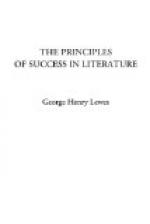palace, temple, or landscape would have affected in
reality. On the other hand the most lively and
spirited verbal description I can give raises a very
obscure and imperfect
idea of such objects; but
then it is in my power to raise a stronger
emotion
by the description than I can do by the best painting.
This experience constantly evinces. The proper
manner of conveying the
affections of the mind
from one to the other is by words; there is great
insufficiency in all other method of communication;
and so far is a clearness of imagery, from being absolutely
necessary to an influence upon the passions, that
they may be considerably operated upon without presenting
any image at all, by certain sounds adapted to that
purpose.” If by image is meant only what
the eye can see, Burke is undoubtedly right.
But this is obviously not our restricted meaning of
the word when we speak of poetic imagery; and Burke’s
error becomes apparent when he proceeds to show that
there “are reasons in nature why an obscure
idea, when properly conveyed, should be more affecting
than the clear.” He does not seem to have
considered that the idea of an indefinite object can
only be properly conveyed by indefinite images; any
image of Eternity or Death that pretended to visual
distinctness would be false. Having overlooked
this, he says, “We do not anywhere meet a more
sublime description than this justly celebrated one
of Milton, wherein he gives the portrait of Satan
with a dignity so suitable to the subject.
“He above the rest
In shape and gesture proudly eminent
Stood like a tower; his form had not yet lost
All her original brightness, nor appeared
Less than archangel ruined and the excess
Of glory obscured: as when the sun new risen
Looks through the horizontal misty air
Shorn of his beams; or from behind the moon
In dim eclipse disastrous twilight sheds
On half the nations; and with fear of change
Perplexes monarchs.”
“Here is a very noble picture,” adds Burke,
“and in what does this poetical picture consist?
In images of a tower, an archangel, the sun rising
through mists, or an eclipse, the ruin of monarchs,
and the revolution of kingdoms.” Instead
of recognising the imagery here as the source of the
power, he says, “The mind is hurried out of itself,
[rather a strange result!], by a crowd of great and
confused images; which affect because they are crowded
and confused For, separate them, and you lose much
of the greatness; and join them, and you infallibly
lose the clearness.” This is altogether
a mistake. The images are vivid enough to make
us feel the hovering presence of an awe-inspiring figure
having the height and firmness of a tower, and the
dusky splendour of a ruined archangel. The poet
indicates only that amount of concreteness which is
necessary for the clearness of the picture,—–only
the height and firmness of the tower and the brightness
of the sun in eclipse. More concretness would




